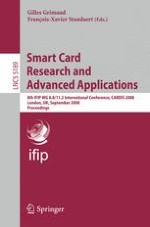2008 | Buch
Smart Card Research and Advanced Applications
8th IFIP WG 8.8/11.2 International Conference, CARDIS 2008, London, UK, September 8-11, 2008. Proceedings
herausgegeben von: Gilles Grimaud, François-Xavier Standaert
Verlag: Springer Berlin Heidelberg
Buchreihe : Lecture Notes in Computer Science
